Speakers on the Seatrade Maritime News webinar “The future of transhipment hubs post-pandemic”, sponsored by Colon Container Terminal (CCT) and Saam Towage dusted off their crystal balls to try and see what the future holds in an uncertain economic outlook.
While transhipment hubs may have enjoyed a higher proportion of volumes in 2020 versus import/export ports, Lars Ostergaard Nielsen, Head of Americas Liner Operations Cluster, Maersk, cautioned that this did not necessarily mean the total number of transhipment moves had gone up, given lower volumes as whole.
This was borne out by the comments of terminal operators SSA International and CCT.
Stephen Shaffer, President of CCT noted that it would depend on the performance of the spoke economies that hubs such as terminals in Panama serve. “Coming off of a low base this year for some economies they may have a bounce back which will see some uptick in volumes but maybe not to the 2019 levels of growth in consumption,” he said.
Taking a similar view was Carlos Urriola, President of SSA International & President of Manzanillo International Terminal - Panama, S.A. (MIT). “We don’t think we will be back to 2019 levels next year, I think there will be a trend to recover some of the volumes but I don’t think we will be able to grow at the level of this year,” he said.
“We have to be extremely careful not be over optimistic that we will be having greater volumes because we have to see that the economy recovers.”
Urriola noted there were a lot of variables at play such as the large increase in volumes currently being seen into the US West Coast.
Shaffer also commented this trend saying, “We have a lot of growth in the US market for this region, but at some point that plays itself out and you get back to a more stable condition. Right now I would look to the spokes and the Latin American market for this region it definitely has some challenges ahead – it has not been an easy time.”
Looking to the shipping line side of the equation Nielsen from Maersk said a trend of lines favouring the utilisation of their larger tonnage was set to continue in an effort to manage unit cost.
“Being in a low margin industry we’re constantly having to look for opportunities to drive down our production cost, and of course making the best use of larger tonnage is a help, and that lends itself to transhipment,” he explained.
“I think we continue to see people trying make use of the bigger tonnage in their fleets.”
Copyright © 2024. All rights reserved. Seatrade, a trading name of Informa Markets (UK) Limited.
Add Seatrade Maritime News to your Google News feed.  |

